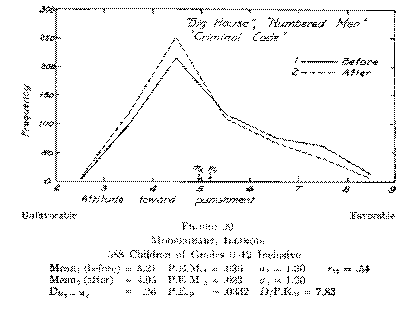Motion Pictures and the Social Attitudes of Children
Chapter 3: The Cumulative Effect of Pictures
Ruth C. Peterson & L. L. Thurstone
Table of Contents | Next | Previous
Attitude toward war
A SERIES of experiments on the cumulative effect of motion pictures was conducted in Mooseheart, Illinois, during the summer of 1931. Mooseheart is a community organized and maintained by The Loyal Order of the Moose for the children of deceased members of the Order. The experiments were made possible through the interest and cooperation of Mr. Ernest N. Roselle, Superintendent of Mooseheart, Mr. Martin L. Reymert, Director of Mooseheart Laboratory for Child Research, Mr. V. A. Bird, Director of Education, and Mr. L. A. Meyer, Research Assistant. Their help was very generously given.
The experiments at Mooseheart were set up to study the cumulative effect of two or more pictures on the same issue. School sessions continue through the summer at Mooseheart, and the experiments were carried on during July and August, 1931. About 750 children in grades six to twelve inclusive were included in the experimental group. This total group was divided into five subgroups, A, B, C, D, E, including in each subgroup a cross section of the total group.
The following summary gives the set-up of the first experiment, which studied change in attitude toward war. The attitude scale used was the same as the one used in the experiments at Batavia and Paxton, Illinois (see page 24).
( 40)
| July 8, 1931 | -Grades six to twelve inclusive took the scale of attitude toward war. |
| July 20, 1931 | -Groups B and C saw "All Quiet on the Western Front." |
| July 21, 1931 | -Group B took the scale of attitude toward war. Groups C, D, and E saw "Journey's End." |
| July 22, 1931 | -Groups C, D, and A took the scale. Group E saw "All Quiet on the Western Front." |
| July 23, 1931 | -Group E took the scale. |
This set-up gave the following data
(1) Group A-Attitude score with two weeks' interval with no interposed motion
picture.
(2) Group B-The effect of the film "All Quiet on the Western Front."
(3) Group C-Cumulative effect of "All Quiet on the Western Front" and
"Journey's End" seen in that order.
(4) Group D-The effect of the film "Journey's End."
(5) Group E-Cumulative effect of films "Journey's End" and "All Quiet on the
Western Front" seen in that order.
The table gives a résumé of the results.
| Group | j N | Picture | M, | M2 | D | P.E.D | Dip.Ed. |
| A | 150 | None | 5.04 | 4.92 | 0.12 | 0.07 | 1.85 |
| B | 152 | "All Quiet on the Western | |||||
| Front" | 5.05 | 4.56 | 0.49 | 0.07 | 6.97 | ||
| C | 148 | "All Quiet" and "Journey's | |||||
| End" | 4.95 | 4.46 | 0.49 | 0.06 | 8.26 | ||
| D | 147 | "Journey's End" | 4.91 | 4.58 | 0.33 | 0.07 | 5.07 |
| E | 148 | "Journey's End",and "All | |||||
| Quiet" | 5.06 | 4.52 | 0.54 | 0.07 | 8.06 | ||
It may be noted that the picture "All Quiet on the Western Front" had a greater single effect than the picture "Journey's End." The group who saw "Journey's End" after they had seen "All Quiet on the Western Front" showed no greater absolute change in attitude than the group who saw only "All Quiet on the Western Front."
( 41)
The group who saw "Journey's End" first and "All Quiet on the Western Front" subsequently, showed the largest absolute change of attitude. If the differentiating ratios are observed, however, it is noted that groups C and E, who saw both pictures, had the most significant changes in attitude. From the above data we offer the conclusion that two films on the same issue show a cumulative effect on the children's attitude.
The diagrams below give the frequency distributions and statistical facts for each group.
Figure 21 presents the distribution of attitude, before and after seeing the motion pictures, for the combined groups B, C, D, and E. This excludes Group A who did not see either of the pictures. The mean attitude score of this


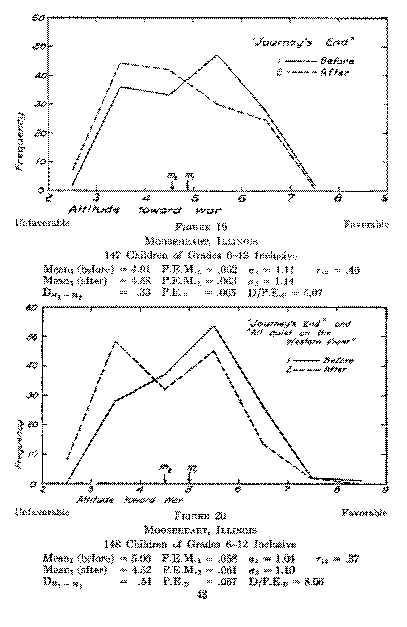
(44) combined group before the pictures were shown was 4.99; after, 4.53, a change of .46 of a scale step with a P.E.D of .0323 and a ratio of the difference to the P.E.Dof 14.24.
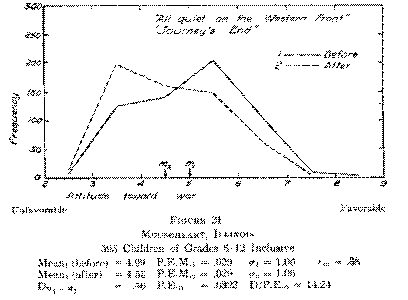
Three crime pictures and the punishment of criminals
The second series of experiments utilized a similar grouping and studied the effect of three films on attitude toward punishment of criminals. The attitude scale used in this experiment was the same as the one used at Watseka, Illinois (see page 28).
The set-up of this series was as follows:
| July 27, 1931 | Grade six to twelve inclusive took the scale of attitude toward the punishment of ciminals |
| August 5, 1931 | Groups A, B, and C saw “Big House |
| August 6, 1931 | Group C took the attitude scale |
(45)
| August 12, 1931 | Group A, B, and D saw “Numbered Men” |
| August 13, 1931 | Group B, and D took the attitude scale |
| August 19, 1931 | Groups A, C, and D saw “The Criminal Code” |
| August 19, 1931 | Groups A, C, and D saw “The Criminal Code” |
| Group A — | Cumulative effect of the three films " Big House," "Numbered Men," and "The Criminal Code." |
| Group B — | Cumulative effect of the two films, "Big House" and "Numbered Men." |
| Group C — | Single effect of "Big House." Cumulative effect of "Big House" and "The Criminal Code." |
| Group D — | Single effect of "Numbered Men."
Cumulative effect of "Numbered Men" and “The Criminal Code” |
| Group E — | Attitude scores at three weeks' interval with no interposed propaganda. |
A summary of the results is given in the following table:
| Film | N | M1 | M2 | D | P.E.D | D/P.E.D |
| “Big House” | 138 | 5.14 | 5.13 | -0.01 | 0.079 | x |
| “Numbered Men” | 168 | 5.23 | 5.27 | 0.04 | 0.065 | x |
| “Big House” and “Numbered Men” | 143 | 5.23 | 5.03 | -0.20 | 0.066 | 3.0 |
| “Big House” and “The Criminal Code” | 138 | 5.14 | 4.97 | -0.17 | 0.076 | 2.2 |
| “Numbered Men” and “The Criminal Code” | 168 | 5.23 | 4.95 | -0.28 | 0.072 | 3.9 |
| “Big House” “Numbered Men” “Criminal Code” | 139 | 5.22 | 4.53 | -0.39 | 0.059 | 6.7 |
| No Film | 167 | 4.95 | 4.98 | +.03 | .067 | x |
The above table shows that neither "Big House" nor "Numbered Men" had a measurable effect on the children's attitudes; however, the group who saw both pictures showed a significant change in attitude toward the punishment of criminals as a result of seeing the films. The effect
(46) of the films "The Criminal Code" and "Big House" was smaller than the effect of "The Criminal Code" combined with "Numbered Men." This difference may be partially explained by the fact that the former group had a lower score before. The group who saw all three pictures showed the greatest change in attitude. The results of this experiment indicate that the effect of motion pictures on attitude is cumulative. A combination of two pictures on the same issue, neither of which has a measurable effect, may show a significant change of attitude toward the issue in question. The cumulative effect of motion pictures is illustrated further by the effect of a combination of three films on the same issue.
The results for each group are presented graphically below.

( 47)
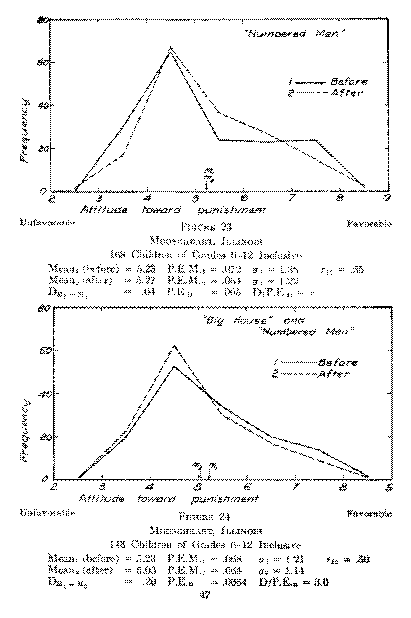
(48)

( 49)
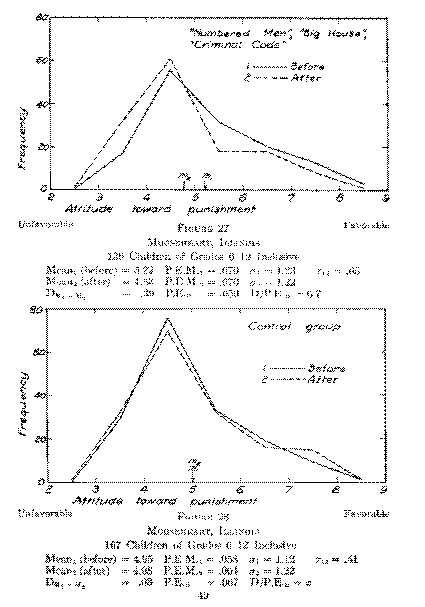
( 50)
Figure 29 shows the distribution of attitude toward the punishment of criminals for the entire experimental group, exclusive of the control group. The mean attitude of the 588 children in the total group (excluding Group E) was 5.21 before the pictures were shown and 4.95 after. The difference is .26 with a REDof .0332, giving a ratio of 7.83.
